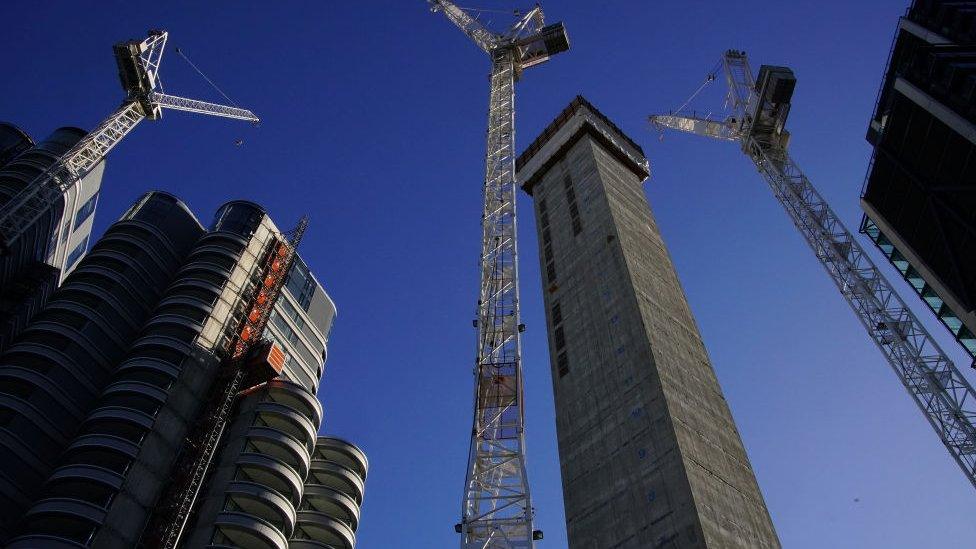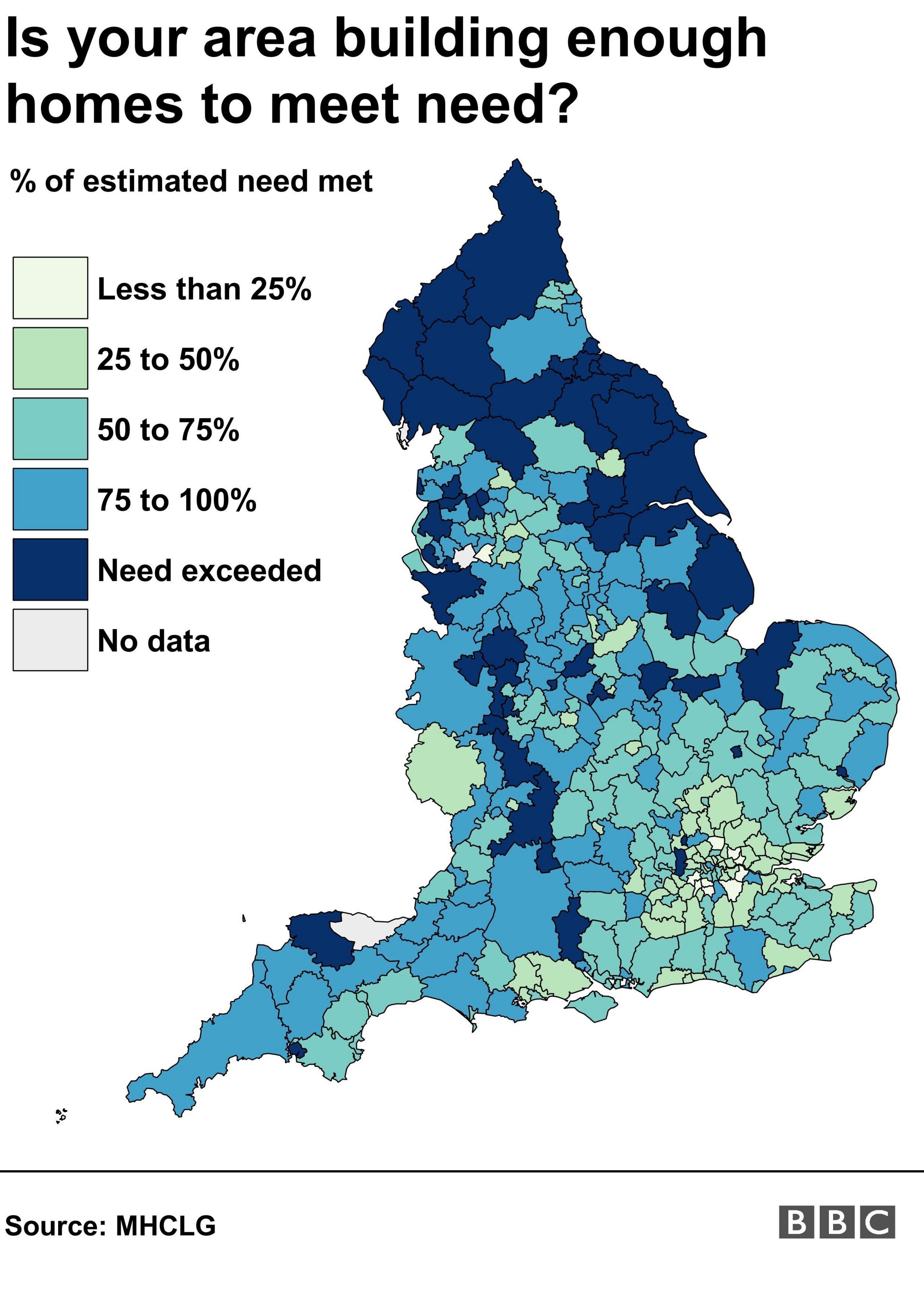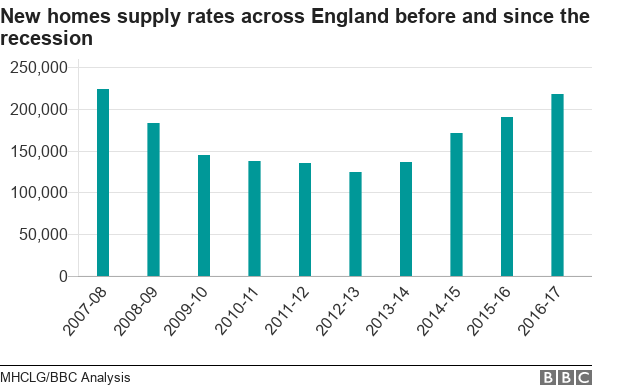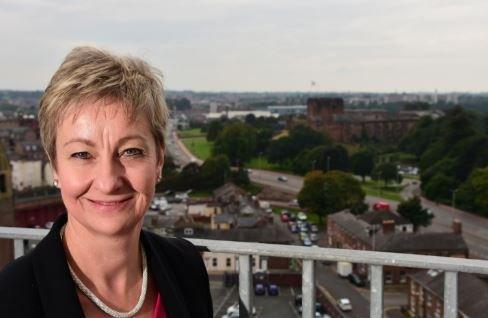UK house-building 'below pre-crash levels'
- Published

House-building across half of England is slower than it was before the financial crash, analysis suggests.
Almost a decade on from the 2008 crisis, some 52% of councils saw fewer homes built last year than in the year leading up to the crisis.
The Federation of Master Builders said the planning system was too "complex, difficult and costly to navigate".
The government said last year saw the largest percentage increase in new homes in nine years.
Overall, some 217,000 new homes were built in 2016-17, two-thirds of the government target of 300,000. These include conversions of existing buildings, as well as new homes.

Our analysis also found:
Some 80% (267) of local authority areas saw fewer homes built annually than the government estimates they need
Nine of the 10 local authorities that saw the fewest number of homes built compared to government estimates of need fall within London. Outside of London, three of the top ten fall within Greater Manchester.
In contrast, large parts of Cumbria and North Yorkshire exceeded those targets
In Wales, only three areas - the Vale of Glamorgan, Flintshire and Newport - saw new builds exceed their annual estimate of need
The Scottish Government said it did not set house-build targets for local authorities
In Northern Ireland - five out of 11 areas - saw house-building exceed targets
James Prestwich, head of policy at the National Housing Federation, said around 340,000 homes should be built in England every year.
He said: "We haven't been building the homes the country needs for some considerable time. It's been about 40 years or more since we last built enough homes to keep pace with demand," he said.


Four ways to tackle the housing crisis
1. Simplify the planning process

Andrew Dixon, of the Federation of Master Builders, said: "Since the financial crisis, finance has been harder to come by.
"The planning system has become much more complex, difficult and costly to navigate. It's disproportionately costly for small builders. The planning process is essentially the same for a five unit development as it is for a 500 unit development.
"But the biggest factor is the lack of availability of smaller sites and smaller development opportunities, and I think the planning system has played a major role in that."
2. Build in cities

Anthony Breach, of the Centre for Cities think tank, said: "There's been a massive failure to build enough housing in the cities where demand has been highest over the past 25 or 30 years.
"It's not even just a big city problem. Even places like Cambridge and Oxford are places which have experienced lots and lots of economic growth over the past 10, 15 or 20 years .
"They have very large proportions of highly skilled people. The number of people who want to live in these cities and experience that growth is very high but supply of housing has completely failed to keep up with that."
3. Attract developers

Jane Meek, the corporate director of economic development at Carlisle City Council, has overseen the authority exceed housing targets.
She said: "We have actually gone out and marketed Carlisle to developers to get developers up here.
"We have a big local developer who is based in Carlisle. They have a very good product and I'm always saying 'do more, we need you to do more than the 30 or 40 a year on site'.
"The only way you can deliver more is by having more developers in an area, and that has helped to increase our delivery.
4. Drop nimbyism
A campaign group is demanding urgent action from authorities to address the housing crisis. It comes together under the banner Yes In My Back Yard.
John Myers, the co-founder of the London branch, believes communities should be empowered to build for themselves.
He said: "This is a national emergency. This should require a national effort on the scale of what we did after the Second World War. We just need to ramp things up and pull together as a nation because if we don't, this is just going to get worse and worse."

A spokesman for the Ministry of Housing, Communities and Local Government said it was committed to building a housing market "fit for the future" with 217,000 new homes delivered in England last year.
"This is up 15% on the previous year and the highest increase in nine years," he said.
"We have also set out an ambitious programme of reforms to boost housing supply - including planning reform and targeted investment to help us deliver an additional 300,000 properties a year by the mid-2020s."
Labour's shadow housing secretary John Healey said the government had "chopped and changed the planning rules," cut investment in affordable homes and weakened the power of councils to drive bargains with developers.
"The housing crisis is getting worse," he said.